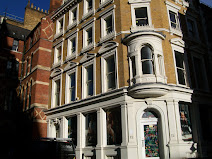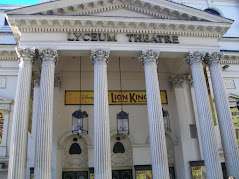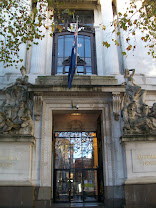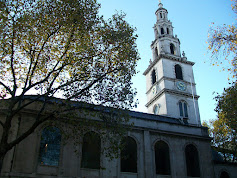Linking the City of Westminster
and the City of London, The Strand is one of London's main highways. It is less
than a mile in length, and was in the twelfth century, no more than a bridle
path beside the river. However, by the eighteenth century it had become a
fashionable shopping street, with the New Exchange built by Robert Cecil, and
Thomas Twining's tea business, which has remained at No 216 since 1706 (making
it the oldest rate-payer in City of Westminster). It also had multiple links to Sherlock
Holmes, being mentioned in the first chapter of the first Sherlock Holmes
story, ‘A Study in Scarlet’, and gave its name to the magazine that first published the
sixty short stories and third and fourth novels. Sir Henry Baskerville also
bought a pair of new boots at a shop in the street [HOUN], and Holmes
once asked a disguised John Clay for directions to The Strand [REDH]. A
stroll down The Strand was therefore called for.
Catching the Northern
Line from Morden, I made my way to Charing Cross Station at the Trafalgar
Square end of The Strand. The original Charing Cross Station building was built
on the site of the Hungerford Market by the South Eastern Railway and opened on
11 January 1864. The station was designed by Sir John Hawkshaw, with a single
span wrought iron roof arching over the six platforms on its relatively cramped
site. It is built on a brick arched viaduct, the level of the rails above the
ground varying from 13 feet (4m) at the north-east end to 27 feet (8.2m) at the
bridge abutment at the south-east end. A year
later the Charing Cross Hotel, designed by Edward Middleton Barry, opened on 15
May 1865 and gave the station an ornate frontage in the French Renaissance
style.
It was in the waiting room of
Charing Cross Station, that Holmes had his canine tooth knocked out by a
villain named Matthews [EMPT]. It was also from this station that Irene
Adler and her new husband Godfrey Norton made their escape [SCAN], Mme.
Fournaye began her journey back to Paris [SECO], and from where Holmes
and Watson travelled to both The Abbey Grange [ABBE] and Yoxley Old
Place [GOLD].
"My collection of M's is a fine one. Moriarty
himself is enough to make any letter illustrious, and here is Morgan the
poisoner, and Merridew of abominable memory, and Mathews, who knocked out my
left canine in the waiting-room at Charing Cross, and, finally, here is our
friend of tonight." -Holmes [EMPT]
Crossing the road, I reached #447
The Strand, which was formerly the Charing Cross Telegraph Office, from where telegrams
were sent by Cyril Overton [MISS] and John Scott Eccles [WIST],
as well as an anonymous threat to Sir Henry Baskerville [HOUN], all had
'a Strand postmark'. It is now a branch of ‘Accessorise’. Also, the American
Exchange in The Strand was the correspondence address for Enoch Drebber and
Joseph Stangerson whilst they were in London [STUD]
A little further along was the
former site of the Lowther Arcade, through which Watson dashes in ‘The Final Problem’,
was eighty feet long and surmounted by glass domes, opening in 1830. However,
it was demolished in 1904 to make way for Coutt's Bank.
Retracing my steps, I made my way onto Adelaide Street, and the exit from the Lowther Arcade where Watson met a brougham driven by a disguised Mycroft Holmes. [FINA]
“In the morning
you will send for a hansom, desiring your man to take neither the first nor the
second which may present itself. Into this hansom you will jump, and you will
drive to the Strand end of the Lowther Arcade, handing the address to the
cabman upon a slip of paper, with a request that he will not throw it away.
Have your fare ready, and the instant that your cab stops, dash through the
Arcade, timing yourself to reach the other side at a quarter-past nine” - Holmes [FINA]
In the 1830's, improvements were
made to the west end of The Strand, with Charing Cross Hospital being built by
the ubiquitous Decimus Burton, in the triangle bounded by Agar Street, William IV Street (which I turned into) and Chandos Place. Doctor Mortimer previously
worked at Charing Cross Hospital [HOUN], and it was here that Holmes was
carried after a murderous attack [ILLU]. The hospital is now Charing
Cross Police Station.

Returning to The Strand, I made
my way along to the Adelphi Theatre. The Strand is currently well known for its
theatres, including the Adelphi, where Watson's literary agent, Sir Arthur
Conan Doyle mounted a theatrical production of ‘The Speckled Band’,
when an earlier effort, ‘The
House of Temperley’ (based on ‘Rodney
Stone’) was a critical disaster, and he had over five months of his
sub-letting of the theatre to go. This performance with its rubber snake was
more of a success. The Adelphi currently plays host to ‘Back to the Future – The
Musical’ (Highly recommended)


Walking past two other places of
interest but wanting to see them in a more chronological order, I turned left
up Burleigh Street (after taking a photo of the corner) until I reached #12. The
first
offices of ‘The
Strand Magazine’ were here (along with those of ‘TitBits’). This
was a monthly magazine founded by George Newnes, composed of short fiction and
general interest articles, which saw the first publication of all Sherlock
Holmes short stories. It was published in the United Kingdom from January 1891
to March 1950, running to 711 issues, though the first issue was on sale well
before Christmas 1890. Sales increased in the early months, before settling
down to a circulation of almost 500,000 copies a month which lasted well into
the 1930s. It was edited by Herbert Greenhough Smith from 1891 to 1930. The
street took its name from Lord Burleigh, a leading statesman in the time of
Elizabeth I, who lived on the site of the office of the Magazine. The cover of
the Magazine included a Burleigh Street sign, an arrow pointing towards number
12, and the number 359 representing the number of the property on the Strand
that was on the corner illustrated by George Haité.



Continuing up Burleigh Street, I turned left onto Tavistock
Street, then left again onto Southampton Street. After
just under a year, Newnes expanded, launching more magazines and had to move
out of the Burleigh Street office. The company didn’t go far – just two streets
along the Strand, to 7-12 Southampton Street. The street name was altered on
the Magazine cover to match the new address, and the number 359 taken off the
building wall. In addition, the company’s new name and address was printed
along the bottom of the cover.
Continuing down Southampton Street, I rejoined The
Strand, and the part known for its hotels, namely the Strand Palace, and most impressively,
The Savoy, which when it opened in 1886 with 600 bedrooms was the largest in Europe.
Before meeting Holmes, Watson had been residing in a private hotel in The
Strand (so presumably not one of these) [STUD].
“I naturally gravitated to
London, that great cesspool into which all the loungers and idlers of the Empire
are irresistibly drained. There I stayed for some time at a private hotel in
The Strand, leading a comfortless, meaningless existence, and spending such
money as I had, considerably more freely than I ought.” - Watson [STUD]
Crossing the road again, I
reached Simpsons-in-the-Strand,
which originally opened as a home of chess, not becoming one of London's most
famous restaurants until 1848, when its good roast beef and saddles of mutton
became world-famous. The premises were demolished in 1900 to allow for widening
of the road, but the restaurant was rebuilt and reopened in 1904, from which
time it became the meeting and luncheon place for gentlemen, including King
George IV, Charles Dickens, Sir Arthur Conan Doyle, and even the world's 'first
consulting detective' and his medico assistant. Holmes and Watson regularly
attended 'Simpsons', even going as far as to label it 'our Strand restaurant'. [DYIN,
ILLU]. Unfortunately, the restaurant has not yet re-opened after it was
forced to close due to the Covid 19 lockdown, with its future seemingly in
doubt. I have eaten at Simpsons only once, as part of the Sherlock Holmes
Society of London’s Jubilee Weekend in 2011.


"I think that something
nutritious at Simpson's would not be out of place..." - Holmes [DYIN]
“It was not possible for me to
follow the immediate steps taken by my friend, for I had some pressing
professional business of my own, but I met him by appointment that evening at
Simpson's, where, sitting at a small table in the front window and looking down
at the rushing stream of life in The Strand, he told me something of what had
passed” - Watson [ILLU]
Back on the other side of the road, I turned left into
Wellington Street, reaching the Lyceum Theatre. It was at the third pillar from
the left that Holmes, Watson and Mary Morstan waited to meet her mysterious
benefactor. [SIGN] It was also
where William Gillette's play, 'Sherlock
Holmes' was performed in 1901. The Lyceum is currently the long-term
home of ‘The Lion King’.
(Also highly recommended)


Back on The Strand, I
crossed over the road on Waterloo Bridge, reaching Somerset House. This
building, originally the site of a Tudor palace, was designed by Sir William
Chambers in 1776, and further extended with Victorian wings to the north and
south. It is here that Holmes would have inspected the will of Helen Stoner's
dead mother [SPEC]. I have also visited on a previous sojourn as the
courtyard doubled for the exterior of the Diogenes Club in 'The
Private Life of Sherlock Holmes' (1970), the 'Light Well' served as
the filming location for Blackwood's cell in ‘Sherlock
Holmes’ (2009), and the frontage appeared as Buckingham Palace in 'Holmes and Watson' (2018).

Continuing along The
Strand, passing the abandoned Aldwych Station which appeared in ‘Sherlock: The
Empty Hearse’, I reached St. Mary-le-Strand Church, which is the second
to have this name, the first having been situated a short distance to the
south. The date of its foundation is unclear but it was mentioned in a
judgement of 1222, when it was called the Church of the Innocents, or St Mary
and the Innocents. It was pulled down in 1549 by Edward Seymour, 1st Duke of
Somerset to make way for Somerset House. The parishioners were promised a new
church, which was never built, forcing them to move to the nearby church of St
Clement Danes and afterwards to the Savoy Chapel. Its canonical connection is
its appearance on the front cover of 'The Strand Magazine', with the
steeple of St. Clement Danes (see below).
Continuing to the extreme end of The Strand, I reached
Australia House, a Grade II listed building which contains the High
Commission of Australia, the diplomatic mission of Australia in the United
Kingdom. It is both Australia's first diplomatic mission and the longest
continuously occupied diplomatic mission in the United Kingdom. The foyer of
the Australia House was used as the interior of the auctioneers in ‘Sherlock
Holmes: A Game of Shadows’ (2011). However, signs visible through the
impressive entrance doors indicated that visitors needed an appointment and
that all photography was prohibited inside. I therefore made do with photos of
the outside.
The imposing Exhibition Hall
of the building with its chandeliers and Australian marble columns appeared in ‘Harry
Potter and the Philosopher’s Stone’ (2001), as the interior of Gringotts
Bank.
A short distance away was my final stop, St. Clement Danes Church, whose
steeple appears
behind that of St. Mary-le-Strand on the cover of ‘The Strand Magazine’.
The current building was completed in 1682 by Sir Christopher Wren. Wren's
building was gutted during the Blitz and not restored until 1958, when it was
adapted to its current function as the central church of the Royal Air Force.
The church is sometimes claimed to be the one featured
in the nursery rhyme "Oranges and Lemons" (‘Oranges and Lemons say
the bells of St. Clements’), and the bells do indeed play that tune every
day at 9 am, noon, 3pm and 6pm—as reported in 1940 the church's playing of the
tune was interrupted during World War II due to Nazi bombing. However, St.
Clement's Eastcheap, in the City of London, also claims to be the church from
the rhyme. St. Clement Danes is known as one of the two 'Island Churches', the
other being St. Mary-le-Strand.
This
brought my walk to an end, but I continued for another 10 minutes to City
Thameslink Station, where I caught a train to Peckham Rye and the start of
another Sojourn.


















































